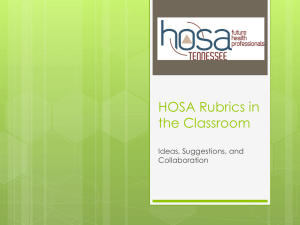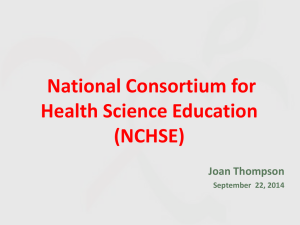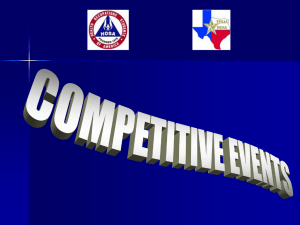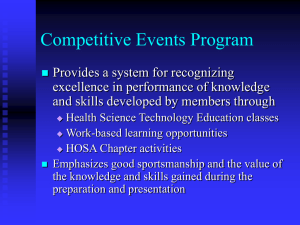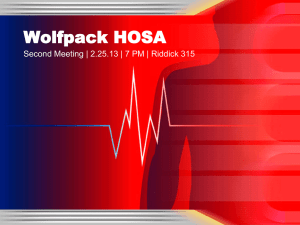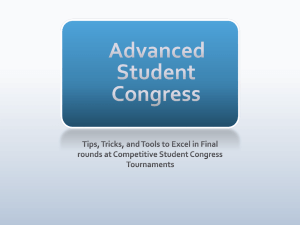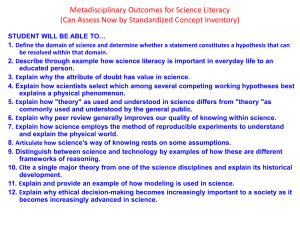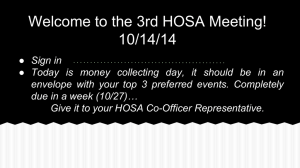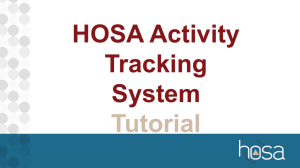Davidson Literacy Standards and Critical Thinking
advertisement
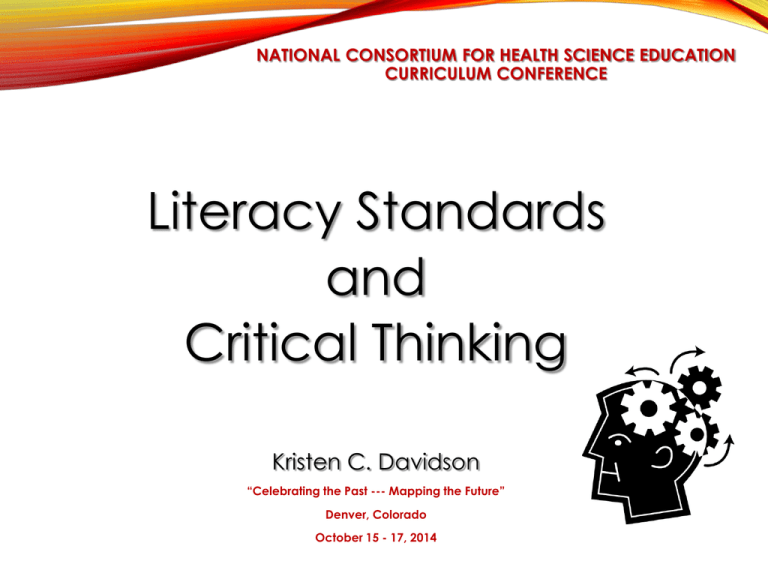
NATIONAL CONSORTIUM FOR HEALTH SCIENCE EDUCATION CURRICULUM CONFERENCE Literacy Standards and Critical Thinking Kristen C. Davidson “Celebrating the Past --- Mapping the Future” Denver, Colorado October 15 - 17, 2014 "Critical thinking is thinking that assesses itself." Center for Critical Thinking, 1996 The quality of our thinking is largely reflected in the quality of our questions. • Inquiry Based Learning LITERACY STANDARDS IN ALL CONTENT Common Core The Common Core State Standards are education standards that were developed by two national organizations in 2010 and adopted by 45 states. Many of today’s educators are looking to the standards as a guide toward improving student learning and achievement. COMMON CORE The stated goal of the English and Language Arts and literacy in History/Social Studies, Science, and Technical Subjects standards is to ensure that students are college and career ready in literacy no later than the end of high school. CROSS-CURRICULAR GOAL Literacy = Reading + Writing + Listening + Speaking Help foster critical thought by: Giving assignments that explicitly focus on student thinking in directions that require reasoning through a problem or issue. “Reading maketh a full man; conference a ready man; and writing an exact man.” Francis Bacon, 1597 HOSA AND THE COMMON CORE HOSA Classroom ● Teacher Directed ● Student Directed ● Outcomes are required ● Students determine the outcome ● Teacher tells students what they need to know ● Part of the school schedule * HOSA is curricular ● Student determines what he/she needs to know ● At school, after school, on weekends and holidays *See HOSA Competitive Events Resources READING IN THE CURRICULUM The Common Core standards in reading are designed to empower students to read, and to read well, the very foundation of success for college, career, and life. READING IDEA Case Study /Discussion Method: • The teacher presents a case to the class without a conclusion. • Using prepared questions, the teacher leads students through a discussion, allowing students to construct a conclusion for the case. *Students write case study, scenario etc. READING IDEA Reader's Questions: • Students write questions on assigned reading. • Teacher selects a few questions as the main focus for class discussion. • Questions may be used for assessment. HOSA AND THE COMMON CORE Events that support Reading: • Medical Reading • Knowledge Tests • HOSA Bowl • Biomedical Debate • Forensic Medicine • Healthcare Issues Exam WRITING IN THE CURRICULUM ARGUMENT IN WRITING • Argument is a statement or proposition with supporting evidence. • Critical thinking involves identifying, evaluating, and constructing arguments that challenge the thinking process. ARGUMENT, PERSUASION, OR PROPAGANDA? Argument Persuasion Propaganda Goal Discover the “truth” Promote an opinion on a particular position Offer “political advertising” for a particular position that may distort the truth or include false information General Technique Offers good reasoning and evidence to persuade an audience to accept a “truth” Uses personal, emotional, or moral appeal to convince an audience to adopt a particular point of view Relies on emotions and values to persuade an audience to accept a particular position Methods Considers other perspectives on the issue May consider other perspectives on the issue Focuses on its own message, without considering other positions Offers facts that support the reasons (in other words, provides evidence) Predicts and evaluates the consequences of accepting the argument Blends facts and emotion to make its case, relying often on opinion May predict the results of accepting the position, especially if the information will help convince the reader to adopt the opinion Relies on biases and assumptions and may distort or alter evidence to make the case Ignores the consequence of accepting a particular position PARTS/TERMS OF ARGUMENTATION • Claim - general statement in the argument that you are asking people to accept • Evidence/Data- support for the claim • Reasoning/Warrant - explains why the evidence/data supports the claim • Counter Claim - objectively reporting on opposing perspectives CLAIM A claim is the main point, the thesis, the hypothesis, the controlling idea of an argument. Students can find the claim by asking the question, “What am I trying to prove? What is my main point?” EVIDENCE Evidence is defined as the reasons given in support of the claim. The support of a claim can come in the form of: • Facts and statistics • Expert opinions • Examples • Explanations • Logical reasoning You can find support by asking, “What information do I need to include to support my claim?” WARRANT The warrant explains why the evidence proves the claim. Writers should use a warrant to answer these questions: • How does the evidence support the claim? • What else must be true for this claim to hold up? COUNTER CLAIM • The counter claim looks at any opposing perspectives. • What claims exist that suggest something different? • Are there other solutions or opinions to the stated claim? (Five solutions to every problem) WHY DOES THIS MATTER? • Students need to be able to state a claim clearly. • Students need to be able to provide evidence to support that claim. • When students can both make claims and then provide the evidence that backs up those claims, they are demonstrating critical thinking and learning. WRITING Use Writing as a way of: • offering and supporting opinions • demonstrating understanding • conveying real and imagined experiences Use Writing Assignments to: • developing critical thinking skills • develop reasoning to argue both sides of an issue. • get to know your students. WRITING ASSIGNMENT IDEA Written dialogues: 1- Give students written dialogues to analyze. 2- Students identify the different viewpoints. 3- Students look for biases, evidence, alternative interpretations, misstatement of facts, and errors in reasoning. 4- Each group decides which view is the most reasonable. 5- After coming to a conclusion, each group acts out their dialogue and explains their analysis. WRITING ASSIGNMENT IDEA Reciprocal Peer Questioning: Following lecture, the teacher displays a list of question stems. (such as, "What are the strengths and weaknesses of...) Students write questions about the lecture material. In small groups, the students ask each other the questions. Then, the whole class discusses some of the questions from each small group. CLASSROOM ASSESSMENT TECHNIQUES (CATS): Use ongoing classroom assessment to monitor and facilitate students' critical thinking. Students write a "Minute Paper" responding to questions such as: • What was the most important thing you learned in today's class? • What question do you have related to this lesson? The teacher selects some of the papers and prepares responses for the next class period. * This assessment is similar to the Exit Ticket. HOSA AND THE COMMON CORE Events that support Writing: • Extemporaneous Writing • Researched Persuasive Speaking • Community Awareness • National Recognition Program • HOSA Week LISTENING IN THE CURRICULUM New technologies have broadened and expanded the role that speaking and listening play in acquiring and sharing knowledge and have tightened their link to other forms of communication. (on-line education, ipad etc.) LISTENING ACTIVITY IDEAS • Case Studies read out loud • Medical Terminology pronunciation practice with partners • Singing activities • Medical dictation practice • Patient history data collection • Explanation of procedures • Introductions and Closures HOSA AND THE COMMON CORE Events that support Listening: • Biomedical Debate • Health Professions Events Dental Science Home Health Aide Medical Assisting Nursing Assisting Physical Therapy Sports Medicine • Public Service Announcement SPEAKING IN THE CURRICULUM Students take part in a variety of rich, structured conversations —as part of a whole class, in small groups, and with a partner. Students collaborate to answer questions, build understanding, and solve problems. SPEAKING ACTIVITY IDEA Spontaneous Group Dialogue: Students role play a discussion scenario. (patient, information giver, opinion seeker, relative, healthcare worker) Observer groups are formed with the functions of determining what roles are being played by whom. Purposes: identify biases and errors in thinking evaluate reasoning skills examine ethical implications of the content COOPERATIVE LEARNING STRATEGIES • Group learning situations are a great way to foster critical thinking through speaking. In cooperative learning environments, students perform active critical thinking with support and feedback from other students and the teacher. (Laboratory and Clinical Practice) HOSA AND THE COMMON CORE Events that support Speaking: • Health Professions Events • Emergency Preparedness Events • Prepared Speaking • Job Seeking Skills • Biomedical Debate • Creative Problem Solving • Health Education • Career Health Display CRITICAL THINKING PROCEDURE Critical thinking makes use of many procedures. • These procedures include: asking questions making judgments identifying assumptions USE ARGUMENTATION TO DEVELOP CRITICAL THINKING • How can health science teachers develop critical thinking skills in students? • How can health science teachers utilize formative and summative assessments to measure student progress? • How can departments collaborate together to cultivate the teaching, learning, and assessing of this skill? CRITICAL THINKING SKILLS • Knowledge • Comprehension • Application • Analysis • Synthesis • Evaluation Bloom’s Taxonomy CRITICAL THINKING SKILLS PYRAMID HANDOUT BRAINSTORM Identify the lesson topics you teach that lend themselves to teaching critical thinking skills. Knowledge Comprehension Application Analysis Synthesis Evaluation •Think ● Pair ● Share DISCUSSION GROUPS Form Five groups: • Questions assigned • Discuss the question with your group • Designate a reporter for the group • Share your ideas, comments, ideas and observations TEACHING AND ASSESSING CRITICAL THINKING IN HEALTH SCIENCE 1- What do we want students to know and be able to do with critical thinking? 2- How will we know if the student learned the critical thinking skills taught? 3- What are the best ways to teach what students need to know and be able to do with critical thinking? TEACHING AND ASSESSING CRITICAL THINKING IN HEALTH SCIENCE 4- How can health science instructors collaborate to improve learning critical thinking skills? 5- How can we collaborate across the curriculum in our schools? Questions Kristen C. Davidson Career and Technical Education Coordinator Northridge High School Layton, Utah kdavidson@dsdmail.net
